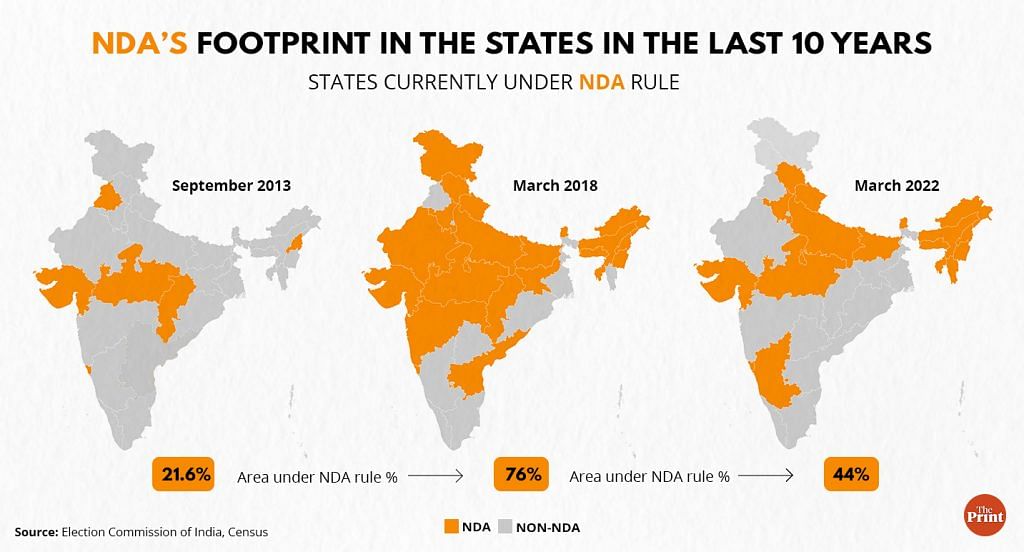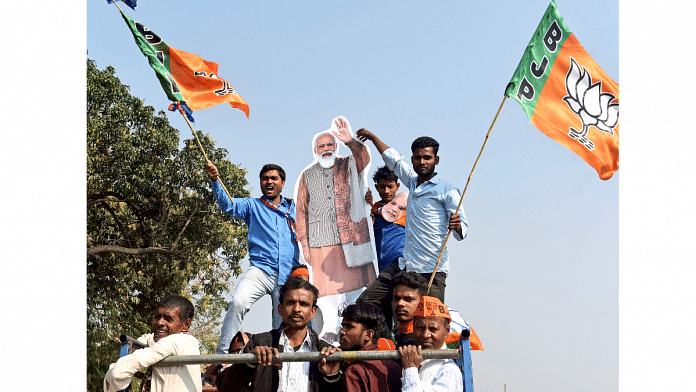New Delhi: As the Bharatiya Janata Party (BJP) retained power in four states, the National Democratic Alliance headed by it is now governing 17 states, covering 44% of India’s territory and 49.6% of its population.
At its peak, in March 2018, the NDA was governing 21 states, covering 70% of the country’s population and 76% area.
The BJP or the NDA’s expansion had begun with the advent of Narendra Modi on the national political centrestage. In September 2013, the BJP had declared him the prime ministerial candidate for the 2014 Lok Sabha polls and, for the next few years, the party went on conquering states, mostly at the expense of the Congress.

The NDA has, however, been on the decline in some states since 2018, even though its supremacy at the national level remains virtually unchallenged.
While the BJP has retained its foothold in the Northeast, it lost some big states in the past four years, starting with Karnataka in the 2018 Assembly election. By the end of that year, the BJP lost three more states — Rajasthan, Madhya Pradesh and Chhattisgarh.
While the party managed to regain power in Karnataka and Madhya Pradesh later — thanks to defection of MLAs — anti-incumbency against BJP-led governments in many states resulted in electoral losses.
The party’s shrinking footprint in states is also attributed to the people’s inclination to vote differently in the Lok Sabha and Assembly elections.
Also read: UP’s ‘rally’ race: PM Modi did more than 2017, CM Yogi crossed double century, Priyanka 2nd
From voting for Modi to judging state govts’ performances
In the initial years after Modi’s arrival on the national centrestage, people were largely voting for him, even in the Assembly elections, no matter who the BJP’s chief ministerial face was or whether there was a CM face at all.
That period saw the BJP’s central leadership springing surprises in its pick of CMs with little experience in running state administrations — Devendra Fadnavis in Maharashtra, Manohar Lal Khattar in Haryana, and Raghubar Das in Jharkhand, among others.
But when the people went to vote in the next round of the Assembly polls, they started judging the performance of state governments.
PM Modi remained popular, as was evident from the 2019 Lok Sabha election, but many BJP CMs had to pay the price for below-par performance.
Fadnavis couldn’t retain power in Maharashtra in 2019, mainly due to ally Shiv Sena’s decision to team up with the Congress and NCP post-polls. Das was unseated by voters in 2019 as well, while Khattar had to depend on the support of Dushyant Chautala’s JJP to get a majority in the Assembly polls of 2019.
In the Assembly elections this year, PM Modi was again the biggest draw. Of the four incumbent BJP CMs — Yogi Adityanath in UP, Pushkar Singh Dhami in Uttarakhand, Pramod Sawant in Goa and N. Biren Singh in Manipur — only the UP chief minister emerged as a leader with some mass base.
But even in UP, the Modi factor played a decisive role in beating anti-incumbency against the Adityanath-led government.
Experts’ view
According to Neelanjan Sircar, senior fellow at the Centre for Policy Research in New Delhi, one of the reasons for the NDA’s shrinking footprint is old generation-CMs who have lost their appeal since Modi became the face in each state poll.
“You have to look at NDA’s lost leadership. Most of the Chief Ministers who lost post 2018 are from the pre-Modi era. Ever since Modi has become the face of delivery of welfare schemes, state CMs who built their appeal on welfare delivery have lost their appeal,” Sircar told ThePrint.
“In fact, Yogi Adityanath became popular only after the 2017 legislative assembly polls, after the results were announced. As things sort out, the older-generation CMs are likely to lose. Will the new CMs come up or Centre-state distinctions remain, that remains an open-ended question,” Sircar added.
Amit Malviya, in-charge of the BJP’s National Information & Technology Department, told ThePrint that the party and its allies will be back to its peak position soon.
“The only change from 2018 to now is Maharashtra, Chhattisgarh, Jharkhand and Rajasthan, which moved out of the BJP’s fold. We will be back to our peak levels when these states go to polls,” Malviya said.
(Edited by Nida Fatima Siddiqui)
Also read: No threat to NDA even if Sena, others form third front as people are happy under Modi govt: Athawale



